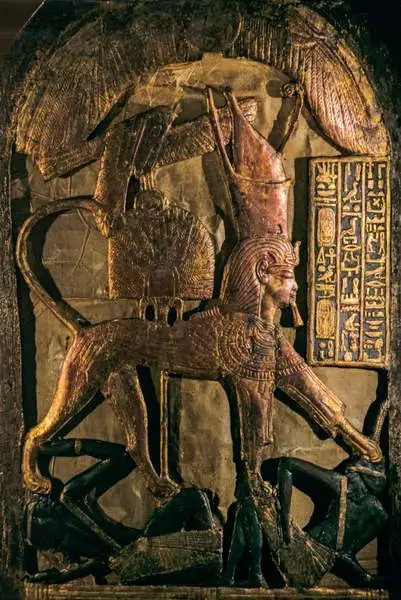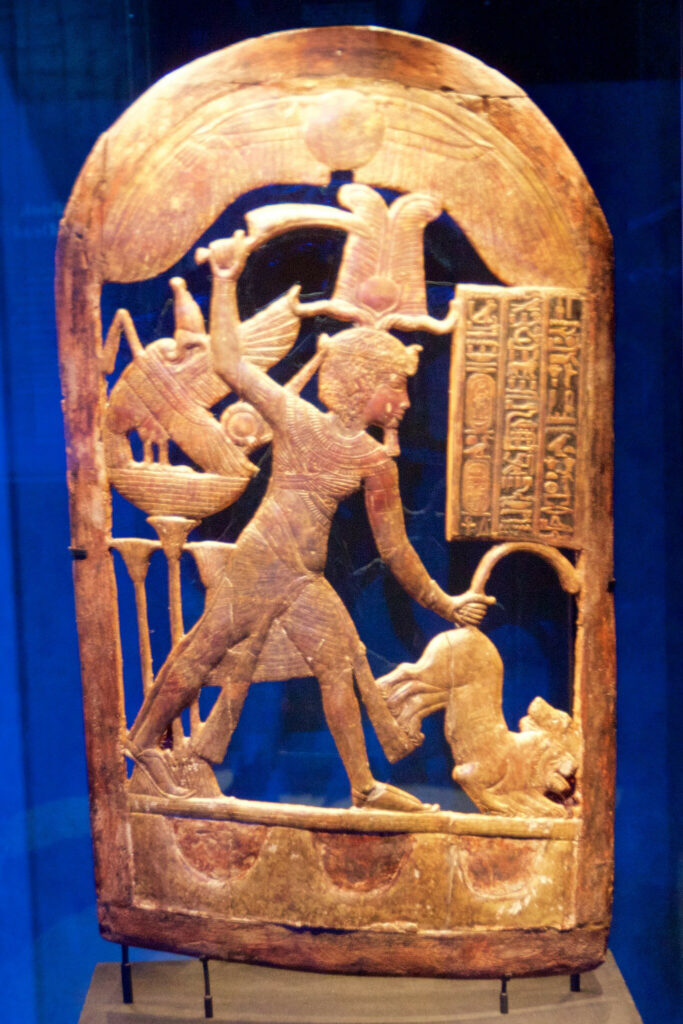Nestled deep within the Valley of the Kings, the tomb of Tutankhamun has long been a source of fascination and wonder. This young pharaoh, who ascended to the throne at just nine years old, left behind a remarkable legacy – one that continues to captivate historians, archaeologists, and the public alike.
Among the countless treasures uncovered in Tutankhamun’s tomb, a set of eight ceremonial shields stands out as a true testament to the artistic excellence of ancient Egypt. These ornate artifacts, crafted from wood and adorned with intricate gilding and incisions, offer a glimpse into the symbolism, power, and divine authority of the boy king.
In this blog post, we’ll delve into the stories behind two of these remarkable shields, exploring the rich symbolism and unparalleled craftsmanship that made them true masterpieces of their time.
The Winged Protector and the Triumphant Pharaoh

One of the most captivating shields from Tutankhamun’s tomb is a wooden masterpiece that showcases the young king’s power and divine authority. At the apex of the shield, a gracefully curving winged sun disk symbolizes the protection of the gods, casting a watchful gaze over the scene below.
Tutankhamun himself is depicted in a pose of dominance and triumph. In one hand, he wields a fearsome scimitar, while the other grasps the tails of two lions – a potent representation of Egypt’s vanquished enemies. This powerful image conveys the young pharaoh’s role as the divinely appointed ruler, tasked with defending and unifying his kingdom.
Adding to the shield’s symbolic power, the vulture goddess Nekhbet spreads her protective wings behind the pharaoh. This divine figure further emphasizes Tutankhamun’s connection to the gods and his status as Egypt’s rightful ruler. Below these central figures, a decorative band evokes the rugged mountains of the desert, grounding the scene in Egypt’s iconic landscape.
Through this intricate and well-crafted shield, we catch a glimpse of the complex symbolism and unwavering belief in the divine right of kingship that permeated ancient Egyptian culture. The young pharaoh is presented as a formidable warrior, a triumphant conqueror, and a divinely appointed ruler – all within the confines of a single, exquisitely decorated wooden shield.
The Sphinx Triumphant

Another ceremonial shield from Tutankhamun’s tomb tells a different, yet equally compelling story. This wooden masterpiece, covered in gilded stucco and inlaid with rich ebony, presents the young king in a unique and powerful form – as a human-headed sphinx.
Wearing the combined crowns of Upper and Lower Egypt, the king-sphinx tramples upon the southern foes of Egypt, likely representing Nubian adversaries. This image not only showcases Tutankhamun’s military prowess and dominance over his enemies but also serves as a powerful symbol of the unified Egyptian state.
Behind this imposing figure of the king, a mysterious face appears, surmounted by a hawk clutching the shen sign – a symbol of eternity. The entire scene is crowned by the familiar winged solar disk, reinforcing themes of divine protection and royal authority.
Through this captivating shield, we witness Tutankhamun’s dual nature as both a mortal ruler and a divinely sanctioned sovereign. The sphinx, a mythical creature with the body of a lion and the head of a human, represents the pharaoh’s connection to the natural world and the supernatural realm. By depicting the young king in this form, the ancient Egyptian craftsmen imbued the shield with a sense of timelessness and eternal power.
The Enduring Legacy of Tutankhamun’s Shields

These magnificent shields, dating to the late 18th Dynasty (circa 1332-1323 BC), offer a glimpse into the complex symbolism and unparalleled craftsmanship of ancient Egypt. Discovered in the famous tomb KV62 in the Valley of the Kings, they now reside in the Grand Egyptian Museum, continuing to captivate visitors with their beauty and historical significance.
The intricate details, the rich symbolism, and the exceptional artistry of these shields bear witness to the remarkable achievements of ancient Egyptian civilization. They serve as tangible reminders of the power, divinity, and cultural legacy of the young pharaoh, Tutankhamun, whose reign left an indelible mark on the pages of history.
As we explore these captivating artifacts, we are transported back in time, immersed in the world of the boy king and the extraordinary civilization that he represented. These shields, with their striking imagery and profound symbolism, invite us to unravel the mysteries of the past and gain a deeper understanding of the enduring influence of ancient Egypt.
Conclusion

The ceremonial shields of Tutankhamun stand as testaments to the artistic brilliance, cultural sophistication, and divine authority of the ancient Egyptian world. Through these remarkable artifacts, we catch a glimpse into the complex symbolism, the unparalleled craftsmanship, and the enduring legacy of the boy king.
As we continue to study and admire these treasures, we are reminded of the profound impact that Tutankhamun’s reign had on the course of Egyptian history. These shields, with their stunning visual narratives and profound meaning, serve as a bridge between the past and the present, inviting us to delve deeper into the rich tapestry of ancient Egyptian civilization.
Perspective through video
